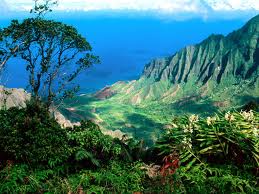- Hawaii's geological origins are volcanic, and the islands remain volcanically active.
- The state's tropical location means warm climates, areas with high precipitation, and abundant plant and animal life.
- Hawaii's population is quite diverse and reflects a strong imprint of Polynesian, European, and Asian cultures.
- Although the islands' economies differ, tourism is important generally in Hawaii's economy more so than in most states.
- Nearly three-quarters of Hawaii's population lives in the Honolulu area.
Some background info on Hawaii:
Hawaii is the only state of the United States that is not geographically located in North America, grows coffee, is completely surrounded by water, is entirely an archipelago, has royal palaces, and does not have a straight line in its state boundary.Hawaii’s tallest mountain, Mauna Kea, stands at 13,796 ft (4,205 m) but is taller than Mount Everest if followed to the base of the mountain, which, lying at the floor of the Pacific Ocean, rises about 33,500 ft (10,200 m).
The eight main islands, Hawaiʻi, Maui, Oʻahu, Kahoʻolawe, Lanaʻi, Molokaʻi, Kauaʻi and Niʻihau are accompanied by many others. Kaʻala is a small island near Niʻihau that is often overlooked.
Hawaii’s climate is typical for the tropics, although temperatures and humidity tend to be a bit less extreme due to near-constant trade winds from the east. Summer highs are usually in the upper 80s °F, (around 31 °C) during the day and mid 70s, (around 24 °C) at night. Winter day temperatures are usually in the low to mid 80s, (around 28 °C) and (at low elevation) seldom dipping below the mid 60s (18 °C) at night.
According to the 2010 U.S. Census, Hawaii had a population of 1,360,301. In terms of race and ethnicity, the state was 24.7% White (22.7% Non-Hispanic White Alone), 1.6% Black or African American, 0.3% American Indian and Alaska Native, 38.6% Asian, 10.0% Native Hawaiian and Other Pacific Islander, 1.2% from Some Other race, and 23.6% from Two or More Races. Hispanics and Latinos of any race made up 8.9% of the population.





No comments:
Post a Comment